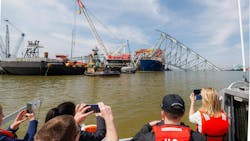Baltimore bridge collapse: Fleet challenges, recovery efforts progress
The collapse of Baltimore’s Francis Scott Key Bridge continues to affect local trucking operations, while recovery efforts make their slow and steady progress.
“It still comes with a lot of challenges relative to going to other ports, trying to keep your customers satisfied, trying to avoid losing customers—which we know has happened,” Luis Campion, president and CEO of the Maryland Motor Truck Association, told FleetOwner. “This isn’t a sustainable approach for our member companies to pick up loads in places like Norfolk or Philadelphia long-term.”
How are local fleets doing?
What has happened so far?
Baltimore’s Francis Scott Key Bridge collapsed on March 26 after the container ship Dali crashed into the bridge. The bridge was part of I-695 and was a major vehicle route for the Port of Baltimore. The bridge’s collapse impacted both local and national trucking operations.
Locally, the collapse limits fleets’ operations in the area. Because of this, local carriers have faced existential challenges. Commercial vehicle drivers affected by the collapse currently have access to regulatory exceptions to help ease operational hurdles.
Recovery efforts have made steady progress in reopening access to the Port of Baltimore, recovering the bodies of workers who died in the collapse, supporting affected local businesses, and eventually rebuilding the bridge.
The bridge collapse closed maritime traffic to the Port of Baltimore and removed a critical span of I-695. These have been detrimental to local fleets’ operations.
Difficulties for regional trucking
Trucking businesses’ operations continue to be affected by the closure of the port and the affected section of I-695.
“I think they [fleets] are certainly challenged by everything from managing the diversion that has occurred to other ports,” Campion told FleetOwner.
The port’s closure causes cargo diversions, requiring fleets to pick up freight from distant terminals such as Norfolk or Philadelphia. The collapse also increases local congestion. These factors push fleets to longer lead times, higher rates, and less operational capacity.
“A driver or an independent contractor who might have gotten three turns in a day, now he can only get one down to Norfolk,” Campion said.
The bright side: Waivers and grants
Government responses to the collapse have helped fleets maintain operations.
“We’ve been really fortunate in the responsiveness of many of the agencies whom we have solicited waivers from and assistance from,” Campion told FleetOwner. “That response has just been incredible.”
Waivers have allowed fleets greater agility in adapting their operations. These regulatory exceptions help drivers reach cargo diversions more easily.
Grants and loans have also helped local businesses retain their workforce and survive the difficult period.
“One of the areas that I will say that the various state and federal agencies have really done a tremendous job is in providing a variety of opportunities for businesses and workers to either have access to SBA loans or various grant programs," Campion said. “That, I would say, has been a phenomenal effort across a number of different agencies.”
Bridge repair timeline, cost estimates
Government response efforts continue to clean up the Port of Baltimore’s channels and plan for bridge reconstruction.
Maryland DOT officials announced the state’s estimated cost and timeline for the bridge’s rebuilding. Maryland plans to rebuild the bridge by late 2028 for roughly $1.8 billion, according to the Associated Press.
Who pays for the damage?
Taxpayers and insurers will likely bear the costs of Maryland’s response efforts and reconstruction.
CBS News reported the state would soon receive a $350 million insurance payment from insurer Chubb, which had written a policy on the bridge. The payment would likely come before construction of the new bridge begins.
Chubb’s payout may be followed by many other insurance claims in the near future. Loretta Worters, a spokesperson for the Insurance Information Institute, told CNN that numerous other claims will pile up over the years, including liability suits and clean-up costs. According to CNN, many of these claims will fall onto a consortium of marine insurance provider clubs covering the cargo ship’s owner business.
Regardless of insurance payouts, the federal government will likely fund most of the new bridge. President Joe Biden pledged full federal funding of response efforts, and legislators introduced bills to Congress that ensure the federal government covers all costs, according to coverage by the Baltimore Sun.
The companies that own and manage the ship responsible for Baltimore’s bridge collapse, Grace Ocean Private Ltd. and Synergy Marine Pte Ltd., filed a “limitation of liability” action to limit their responsibility for the damages, according to Maryland’s The Daily Record. The action would cap the companies’ fiscal liabilities at $43.6 million. The City of Baltimore has made court filings in opposition to the filed action, according to NBC News.
Current status of cleanup efforts
Several investigations into the collapse
Such a major disaster as a bridge collapse prompted investigations from multiple government agencies. The Baltimore Sun released a helpful breakdown of the various known, ongoing investigations.
According to the local news outlet, four agencies are each officially conducting investigations into the collapse: the National Transportation Safety Board’s Office of Marine Safety and Office of Highway Safety are investigating where the cargo ship and bridge’s structural components failed; the U.S. Coast Guard convened a Marine Board of Investigation for its own data collection and to assist NTSB; the FBI has boarded the Dali for an investigation of undisclosed focus; and Maryland Occupational Safety and Health launched a probe into the six workplace fatalities caused by the collapse.
Response efforts temporarily opened a new deep-water channel, wide and deep enough to finally accommodate one-way traffic for commercial cargo ships.
Several cargo ships were able to leave the Port of Baltimore since the channel’s opening in late April, according to the Associated Press. The temporary channel then closed again for further clearance work.
In early April, the U.S. Army Corps of Engineers announced plans to open a 280-ft.-wide and 35-ft.-deep channel by the end of April. USACE is still on schedule to open a 700-ft.-wide and 50-ft.-deep main channel for more vessels by the end of May.
“Ultimately, I think that everyone is really looking forward to when the channel is fully reopened," Campion said.
However, Campion noted that, while the port's resumed activity will help boost local freight movement, it will also aggravate the already problematic local congestion.
“Congestion has increased dramatically since the bridge collapse. But then, that congestion is going to be worse when the port is actually open,” Campion told FleetOwner. “While we’re excited about the prospect of the port reopening here within roughly three weeks—based on the timeline that we’ve been given when the 50-ft. channel is expected—still, after that, there will be different challenges associated with the additional traffic that that’s going to cause.”
About the Author
Jeremy Wolfe
Editor
Editor Jeremy Wolfe joined the FleetOwner team in February 2024. He graduated from the University of Wisconsin-Stevens Point with majors in English and Philosophy. He previously served as Editor for Endeavor Business Media's Water Group publications.

